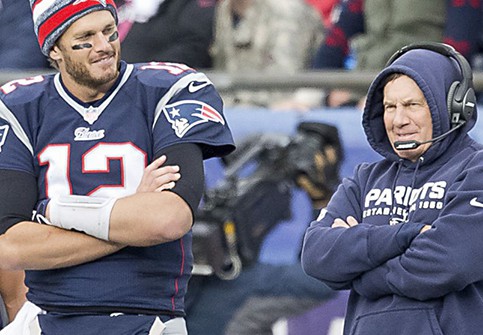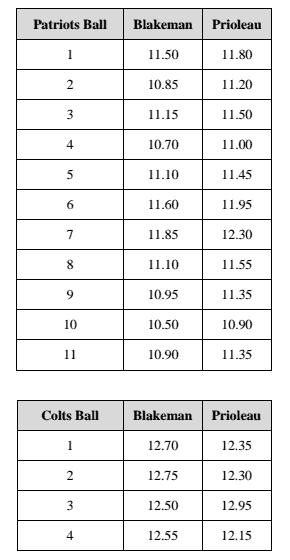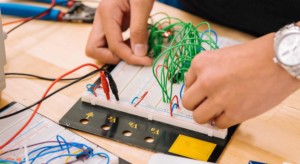5 Teachable ‘Deflategate’ Moments: Connecting Football to STEM

As the Patriots and the NFL work to resolve penalty issues from Deflategate, we can’t help but think about what we can learn from the situation. Whether you believe there was foul play or not, the media’s attention to ‘Deflategate’ has been both overwhelming and intriguing. The silver lining to this attempt of continuing the football conversation long after the season has ended (and 110 days before the season starts) is that there is a golden opportunity for some solid STEM conversation. Whether it be in the classroom or around the dinner table, the information and opinions provided by sports analysts across the nation can be used to make interesting connections to ideas and concepts that may otherwise be confined to a textbook.
We reached out to an NFL veteran and some fellow math and science enthusiasts to develop a list of 5 Deflategate moments that can and should be connected to STEM.
1. The Main Idea: Why a Deflated Ball can be a Better Ball. Any STEM teacher who has worked with students on real world problems understands that students need a basic sense of the issue at hand. Accordingly, before drawing connections to a more complex concept such as the ideal gas law, be sure students understand the basic facts behind what Deflategate and why a deflated ball might be considered advantage. It really comes down to the ability of quarterbacks and receivers to grip and control the ball.
A deflated ball means a ball that is easier to grip and easier to throw and catch.
The Details. Remember, though, in science and life, what’s true in one case may not be true in another. That’s why we talked to veteran NFL kicker Michael Husted (@HustedKicking) to better understand the differences between kickers and quarterbacks on preferred inflation levels. “As a professional kicker, I used to ‘work’ the footballs so that they would travel further when kicked. Having the footballs at the correct psi (13 lbs), but softening the leather, would give us the best scenario to maximize the distance on our kicks. As kickers, we definitely don’t want the football under inflated as that would minimize the effect of the kick. In fact, the current K-ball rule was put into effect because the footballs would sometimes expand from us ‘working’ them and the quarterbacks couldn’t get a good grip on the ball.” Michael is founder of the National Camp Series (which takes an algorithm-based approach to rating kickers) and Husted Kicking.
Conversation Starter. When might a team prefer distance over accuracy? Are there any negative effects that a deflated ball might have on a team’s performance? With all you’ve heard about Deflategate, did you understand that main idea?
2. The Ideal Gas Law: Why Temperature Matters. This is one of the more obvious (and called out) connections between Deflategate and the sciences. If you have ever taken a deflated balloon into a hot car and watched the balloon expand, then you have experienced the ideal gas law in action.
Temperature affects air pressure.
The Details. The ideal gas law states that PV = nRT, where the letters represent pressure, volume, amount (in moles), the ideal gas constant, and temperature respectively. This relationship shows that a change in the average energy, meaning that the air molecules within the balloon (or in the football) are moving at a higher speed and colliding with greater force, will result in more pressure against the surface. In other words, an increase in temperature leads to an increase in pressure. The opposite effect happens when temperature drops (like the drop from a 75 degree locker room to a 50 degree football field).
Conversation starter: Would the temperature effect both teams’ footballs? Did the change in temperature match up with the change in pressure according to the ideal gas law formula? (check out item 10 on the wellsreportcontext as well as this Business Insider article as a resources).
3. Coefficient of Restitution. Why Inflation Matters. This is a measure of elasticity that impacts kinetic energy and helps explains why there are tradeoffs when choosing inflation levels.
Level of inflation will effect elasticity and the ball’s ability to retain energy upon impact.
The details: The property of elasticity, which can be measured by the coefficient of restitution, measures the ball’s ability to retain kinetic energy during a collision. It is a function of the object’s ability to flex without breaking and then return to its original shape. A ball with a lower coefficient of restitution, (which means lower elasticity, which means more inflated), retains more kinetic energy upon collision. That’s good news for a kicker, because the retained energy allows the ball to go farther. For a quarterback or receiver, however, If the ball has higher elasticity (deflated) it will loses kinetic energy and therefore has more ability to flex (easier for a quarterback or receiver to grip).
As high school math teacher Mike Tollefsbol says, “It’s really all about tradeoffs with elasticity. A better grip means increased accuracy and likelihood of completion. Especially on a cold day, it’s worth sacrificing a bit of distance for that.” He went on to acknowledge that using current examples in the classroom is also a tradeoff – it takes more time, but the benefits are worth it.
Conversation starter: How can you apply the coefficient of restitution to striking a guitar chord? Dribbling a basketball? Hitting a baseball? What other daily activities could you apply this property to?
4. Tolerance and variation: Why and How We Measure. When we asked our friend Matthew Feldman from MIND Research Institute, a Getting Smart Advocacy Partner, he pointed out what he would be looking for in the Wells Report – “The question I keep thinking about is with relation to measurement. How accurate are the tools that were used to measure the game balls. What is the tolerance and variation?”
Measurement tools should calibrated regularly to test for accuracy.
The Details. Air molecules move randomly within the football, creating an impact force that keeps the ball inflated. By forcing more air molecules into the confined space (using an air pump) you increase the pressure (and therefore the size and firmness of the ball). By deflating the ball, you decrease the ball creating a lighter, less firm ball that is easier to grip. Air pressure is measured in psi (pounds per square inch) and the NFL officials use several gauges to test and ensure that the game balls fall within the appropriate range of 12.5lb – 13lb. According to the Wells Report, the following measurements were recorded at half time (note the difference in values between the referees, each was using a different gauge).
Conversation starter: Does it matter that the referees noted different pressure readings for the same ball? Does the variance effect both football teams? How might this process change for referees post Deflategate?
5. “The Deflator:” Why Character Matters. Although a creative rebuttal, the “deflator” is probably NOT a nickname given to someone who is trying to lose weight. Okay so this one isn’t really a direct connection to STEM, but come on Patriots, you can do better than that. Show us some of that good ‘ole fashion common sense, critical thinking, and problem solving skills to come up with a better lie than that.
Character Matters. Type your words with intention.
The Details. In the Patriot’s response to the Wells Report, The Wells Report Context they argue that the one of the ball boy’s unfortunate nickname, “The Deflator,” was really just a reference to his attempts to lose weight or deflate…lets stop there. The real lesson here is that character matters. When it comes to texting, social media, etc — words are permanent, so be thoughtful in how you present yourself. Tom Vander Ark said it well in a recent visit with the DECA students at the American International School of Utah, when he explained to the students that every time they are using social media, they are building their brand. Post often, but post wisely.
Conversation starter: Do you feel like the way you are portrayed on social media is positive? Is it something you will be proud of in 10 years?
Perhaps most important is the idea that just about ANY news story can be connected to STEM. Ironically, on the day the recent news broke about Deflategate, one of our sons was studying the Ideal Gas Law in Chemistry. Yet, sadly, his teacher didn’t draw the connection. When asked if it would help, he said, “Yes, it would have, but then again it’s not like everyone who wants to take AP Chemistry also likes football, but it would have at least been more interesting than the book.”
Well said Grant! This brings up the point of personalization. Football isn’t for everyone, but it might be for some. The idea behind sharing these STEM connections is not to share them with every student, but rather to share them with the students that are already talking about Deflategate. As Tim Hudson (@DocHudsonMath) points out in his recent post, Forget “Academics” For Middle School. Focus On Engagement and Authenticity, “Relevance and engagement are essential for all learners, but perhaps they are most critical for young adolescents, who need to cultivate their curiosity and grow their love for learning.”
One parent observed, “The teachers don’t have to come up with all of the connections or examples themselves. They have no idea how motivating extra credit or a piece of gum can be for – if teachers just made a generic standing offer to make a connection between a real life event and something, the students can do the work and it can change the dynamic of the classroom.”
Now, could it have changed the dynamic of the outcome of the football game?
We only scratched the surface here, we could have included proof writing, trajectory, sales numbers, and so on. What did we miss? Keep the conversation going on Twitter with @MegMarMe @MaryRyerse and #SmartMath.
For more blogs by Megan and Mary, check out:
- You Can Thank Mom for More Than the Meal Itself: Family Dinner Matters
- 10 Things the Human Resource Dept. Should do to Advance Next-Gen Learning
- Coding for the Future
Feature image vis abcnews.com.









GordonMcD Science Evangelist
Missing from the entire conversation is why the NFL allows teams to play offense with their own balls in the first place. When we perform a science experiment, we try to limit our variables to the minimum possible. This helps us ensure repeatability and the ability to identify or isolate the characteristics we are exploring. In order for a game, such as football, to be fair, one might be surprised to find that teams get to prepare their own game balls. I find it interesting that there are different balls used for kicks which are better for the kickers, and harder for the catchers. I suspect most fans would rather believe football to be a contest of athletes' skills than a nuancing of equipment.
Megan
Great point Gordon! Thanks for adding.